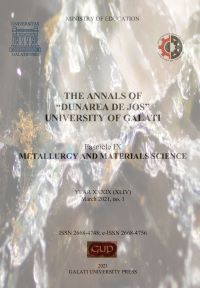Poly(3-HydroxyButyrate-co-3-HydroxyValerate) based Inorganic Consolidate for Firwood Preservation
Abstract
The aim of this study was to address one of the major challenges of the conservation state of wooden artifacts or artworks namely, the preservation and restoration of wood surfaces. The factors involved in the deterioration of wood are mainly the external factors such as fire, low temperature and microbiological agents, which induce some degradation processes in wood, identified by discoloration, fragility and unsightly appearance. In this study, biodegradable materials based on poly(3-hydroxybutyrate-co-3-hydroxyvalerate) (PHBHV) and composites based on PHBHV and particles (zinc oxide (ZnO), carbonated hydroxyapatite (CHAp) and its metallic derivatives with silver (AgCHAp) and strontium (SrCHAp) were applied on firwood specimens in order to investigate their consolidation capacity. Colorimetric measurements have confirmed that the chosen treatments did not change the colour of the natural wood. The hardness test revealed that the consolidation system increases the mechanical properties of the samples. The used treatments confer a strong hydrophobic character which prevents exfoliation of the wood samples, as confirmed by the performed water absorption test.
Downloads
References
[2]. Laks P., Heiden P. A., Compositions and methods for wood preservation, Google Patents, 2003.
[3]. Stark N., Influence of moisture absorption on mechanical properties of wood flour-polypropylene composites, Journal of Thermoplastic Composite Materials, 14(5), p. 421-432, 2001.
[4]. Tajvidi M., Najafi S. K., Moteei N., Long-term water uptake behavior of natural fiber/polypropylene composites, Journal of Applied Polymer Science, 99(5), p. 2199-2203, 2006.
[5]. Badji C., Soccalingame L., Garay H., Bergeret A., Bénézet J.-C., Influence of weathering on visual and surface aspect of wood plastic composites: Correlation approach with mechanical properties and microstructure, Polymer Degradation and Stability, 137, p. 162-172, 2017.
[6]. Fabiyi J. S., McDonald A. G., Wolcott M. P., Griffiths P. R., Wood plastic composites weathering: Visual appearance and chemical changes, Polymer Degradation and Stability, 93(8), p. 1405-1414, 2008.
[7]. La Mantia F. P., Morreale M., Accelerated weathering of polypropylene/wood flour composites, Polymer Degradation and Stability, 93(7), p. 1252-1258, 2008.
[8]. Teng T.-J., Arip M. N. M., Sudesh K., Nemoikina A., Jalaludin Z., Ng E.-P., Lee H.-L., Conventional technology and nanotechnology in wood preservation: A review, BioResources, 13(4), p. 9220-9252, 2018.
[9]. Morrell J. J., Protection of wood-based materials, Handbook of Environmental Degradation of Materials, Elsevier, p. 343-368, 2018.
[10]. Chan C. M., Pratt S., Halley P., Richardson D., Werker A., Laycock B., Vandi L.-J., Mechanical and physical stability of polyhydroxyalkanoate (PHA)-based wood plastic composites (WPCs) under natural weathering, Polymer Testing, 73, p. 214-221, 2019.
[11]. Grigore M. E., Grigorescu R. M., Iancu L., Ion R.-M., Zaharia C., Andrei E. R., Methods of synthesis, properties and biomedical applications of polyhydroxyalkanoates: a review, Journal of Biomaterials Science, Polymer Edition, 30(9), p. 695-712, 2019.
[12]. Radu I. C., Hudita A., Zaharia C., Galateanu B., Iovu H., Tanasa E. V., Georgiana Nitu S., Ginghina O., Negrei C., Tsatsakis A., Velonia K., Shtilman M., Costache M., Poly(3-hydroxybutyrate-CO-3-hydroxyvalerate) PHBHV biocompatible nanocarriers for 5-FU delivery targeting colorectal cancer, Drug Deliv., 26(1), p. 318-327, 2019.
[13]. Clausen C. A., Green F., Kartal S. N., Weatherability and leach resistance of wood impregnated with nano-zinc oxide, Nanoscale research letters, 5(9), p. 1464, 2010.
[14]. Rassam G., Abdi Y., Abdi A., Deposition of TiO2 nanoparticles on wood surfaces for UV and moisture protection, Journal of Experimental Nanoscience, 7(4), p. 468-476, 2012.
[15]. Shiny K., Sundararaj R., Mamatha N., Lingappa B., A new approach to wood protection: Preliminary study of biologically synthesized copper oxide nanoparticle formulation as an environmental friendly wood protectant against decay fungi and termites, Maderas. Ciencia y tecnología, (AHEAD), 2019.
[16]. David M. E., Ion R.-M., Andrei E. R., Grigorescu R. M., Iancu L., Filipescu M. I., Superhydrophobic Coatings Based on Cellulose Acetate for Pinewood Preservation, Journal of Science and Arts, 1(50), p. 171-182, 2020.
[17]. Borges C. C., Tonoli G. H. D., Cruz T. M., Duarte P. J., Junqueira T. A., Nanoparticles-Based Wood Preservatives: The Next Generation of Wood Protection?, Cerne, 24(4), p. 397-407, 2018.
[18]. Ion R.-M., Iancu L., Vasilievici G., Grigore M. E., Andrei R. E., Radu G.-I., Grigorescu R. M., Teodorescu S., Bucurica I. A., Ion M.-L., Ion-Substituted Carbonated Hydroxyapatite Coatings for Model Stone Samples, Coatings, 9(4), p. 231, 2019.
[19]. Iancu L., Ion R.-M., Grigorescu R. M., David M. E., Ghiurea M., Vasilievici G., Stirbescu R. M., Dulama I. D., Double Substituted Carbonated Hydroxyapatite for Stone Consolidation, Journal of Science and Arts, 3(52), p. 713-730, 2020.
[20]. Ion R. M., Iancu L., David M. E., Grigorescu R. M., Trica B., Somoghi R., Vasile S. F., Dulama I. D., Gheboianu A. I., Tincu S., Multi-Analytical Characterization of Corvins’ Castle-Deserted Tower, Construction Materials and Conservation Tests, Heritage, 3(3), p. 941-964, 2020.
[21]. Leimann F., Cardozo Filho L., Sayer C., Araújo P., Poly(3-hydroxybutyrate-co-3-hydroxyvalerate) nanoparticles prepared by a miniemulsion/solvent evaporation technique: effect of phbv molar mass and concentration, Brazilian Journal of Chemical Engineering, 30(2), p. 369-377, 2013.
[22]. Ion R.-M., Iancu L., Grigorescu R.-M., Tincu S., Vasilievici G., Ion N., Bucurica I. A., Teodorescu S., Dulama I. D., Stirbescu R. M., Arhaeometric investigations on ceramic materials from Hunedoara-the court area, Journal of Science and Arts, 18(2), p. 471-480, 2018.
[23]. ***, EN U 15886. Conservation of cultural property, Test methods. Colour measurements of surfaces, 2010.
[24]. ***, ASTM D 2244. Standard Practice for Calculation of Color Tolerances and Color Differences from Instrumentally Measured Color Coordinates, American Society for Testing and Materials, West Conshohocken, PA, 2003.
[25]. ***, ISO 2813: Paints and Varnishes-Determination of Gloss Value at 20 Degrees, 60 Degrees and 85 Degrees, International Organization for Standardization, 2014.
[26]. Aydin F., Saribiyik M., Correlation between Schmidt Hammer and destructive compressions testing for concretes in existing buildings, Scientific Research and Essays, 5(13), p. 1644-1648, 2010.
[27]. Garay R., Inostroza M., Ducaud A., Color and gloss evaluation in decorative stain applied to cases of Pinus radiata wood treated with copper azole micronized Type C, Maderas. Ciencia y tecnología, 19(1), p. 21-38, 2017.



